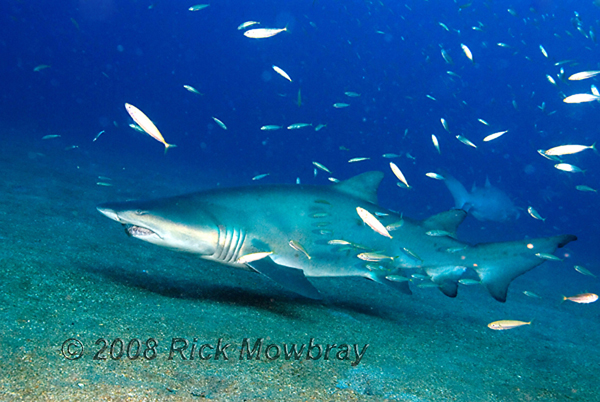Source (google.com.pk)
Sand Tiger Shark Pictures Biography
Sand sharks, also known as sand tigers and gray nurse sharks, have a deceivingly ferocious look. They are large-bodied and display a mouthful of sharp teeth that protrude in all directions, even when the mouth is shut. Despite this, they are a docile, non-aggressive species, known to attack humans only when bothered first.
Sand sharks are brownish-gray with rust-colored spots on top and white underneath. They have a flattened, cone-shaped snout and a distinctive, oblong tail with a notched, upper lobe that is significantly longer than the lobe below. Individuals range in size from 6.5 to 10.5 feet (2 to 3.2 meters) in length.
Their name comes from their tendency toward shoreline habitats, and they are often seen trolling the ocean floor in the surf zone, very close to shore. They are found in warm or temperate waters throughout the world's oceans, except the eastern Pacific.
Sand tigers are the only shark known to come to the surface and gulp air. They store the air in their stomachs, which allows them to float motionless in the water, seeking prey. They are voracious predators, feeding at night and generally staying close to the bottom. Their staple is small fish, but they will eat crustaceans and squid as well. They occasionally hunt in groups, and have even been known to attack full fishing nets.
Although this species is widespread and is not widely fished for food, it has one of the lowest reproduction rates of all sharks and is susceptible to even minimal population pressure. For this reason, it is listed as vulnerable and is protected in much of its range.









Sand Tiger Shark Pictures Biography
Sand sharks, also known as sand tigers and gray nurse sharks, have a deceivingly ferocious look. They are large-bodied and display a mouthful of sharp teeth that protrude in all directions, even when the mouth is shut. Despite this, they are a docile, non-aggressive species, known to attack humans only when bothered first.
Sand sharks are brownish-gray with rust-colored spots on top and white underneath. They have a flattened, cone-shaped snout and a distinctive, oblong tail with a notched, upper lobe that is significantly longer than the lobe below. Individuals range in size from 6.5 to 10.5 feet (2 to 3.2 meters) in length.
Their name comes from their tendency toward shoreline habitats, and they are often seen trolling the ocean floor in the surf zone, very close to shore. They are found in warm or temperate waters throughout the world's oceans, except the eastern Pacific.
Sand tigers are the only shark known to come to the surface and gulp air. They store the air in their stomachs, which allows them to float motionless in the water, seeking prey. They are voracious predators, feeding at night and generally staying close to the bottom. Their staple is small fish, but they will eat crustaceans and squid as well. They occasionally hunt in groups, and have even been known to attack full fishing nets.
Although this species is widespread and is not widely fished for food, it has one of the lowest reproduction rates of all sharks and is susceptible to even minimal population pressure. For this reason, it is listed as vulnerable and is protected in much of its range.
Sand Tiger Shark Pictures

Sand Tiger Shark Pictures

Sand Tiger Shark Pictures

Sand Tiger Shark Pictures

Sand Tiger Shark Pictures

Sand Tiger Shark Pictures
Sand Tiger Shark Pictures

Sand Tiger Shark Pictures

Sand Tiger Shark Pictures

Sand Tiger Shark Pictures

Sand Tiger Shark Pictures
No comments:
Post a Comment